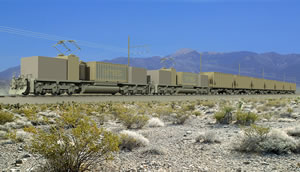Rail Energy Storage Harnesses the Power of Gravity All the Livelong Day
 Glenn McDonald for Seeker: What goes up must come down. This principle applies to most things in our current gravitational setup — college tuition being a conspicuous exception — and it could provide a significant boost to green energy initiatives, too.
Glenn McDonald for Seeker: What goes up must come down. This principle applies to most things in our current gravitational setup — college tuition being a conspicuous exception — and it could provide a significant boost to green energy initiatives, too.
A California-based company called Advanced Rail Energy Storage (ARES) is using the power of gravity to help renewable energy utilities compete with coal and gas. The idea is to help solve the perennial problem of energy storage. Because wind and solar installations can't always generate energy on demand — sometimes it's cloudy and the air is still — green utilities need a reliable method of storing surplus energy.
There are several ways to do this using high-tech industrial batteries, flywheels, or hydroelectric facilities, but these approaches tend to be expensive and complicated.
ARES's solution? Run some old trains up and down a hill.
The company harnesses the power of potential and kinetic energy to help utilities add and subtract to the energy grid as needed. When the wind or solar farm is producing excess energy, that power is shuttled over to the adjacent ARES facility. The surplus energy is used to power repurposed electric locomotives, which in turn haul enormously heavy railroad cars to the top of a hill. Full Article:
Comments (0)
This post does not have any comments. Be the first to leave a comment below.
Featured Product

